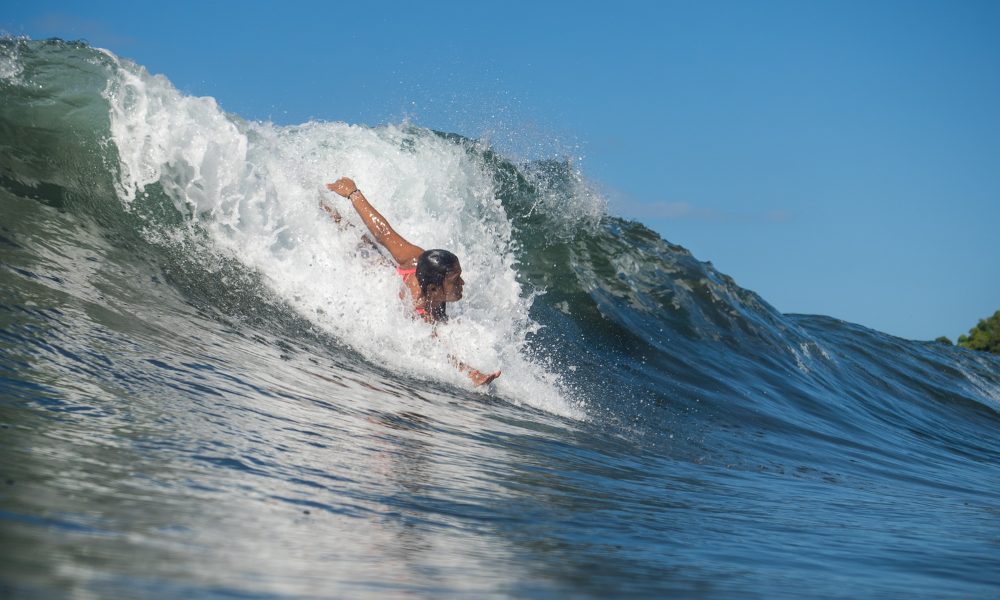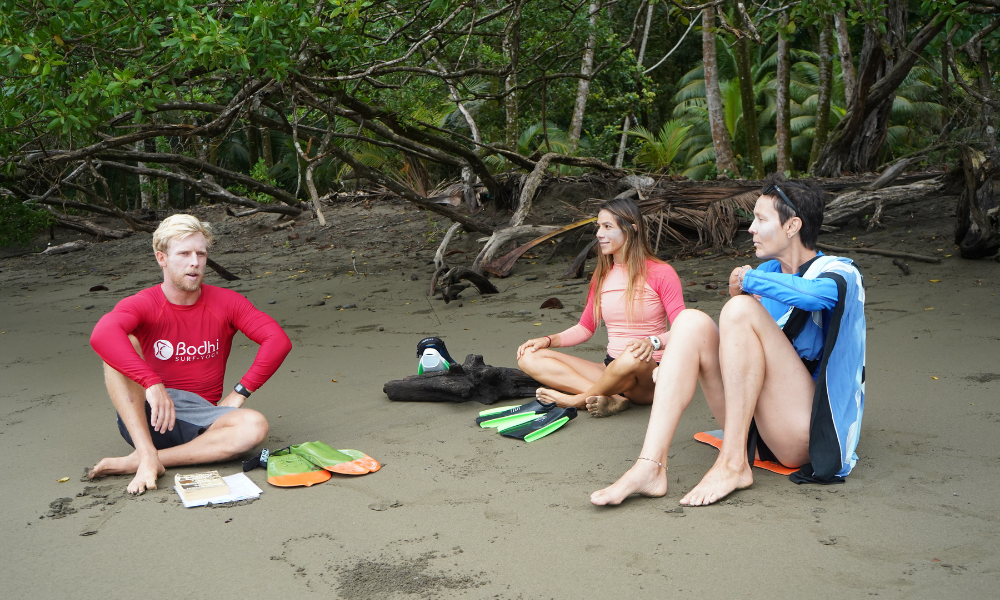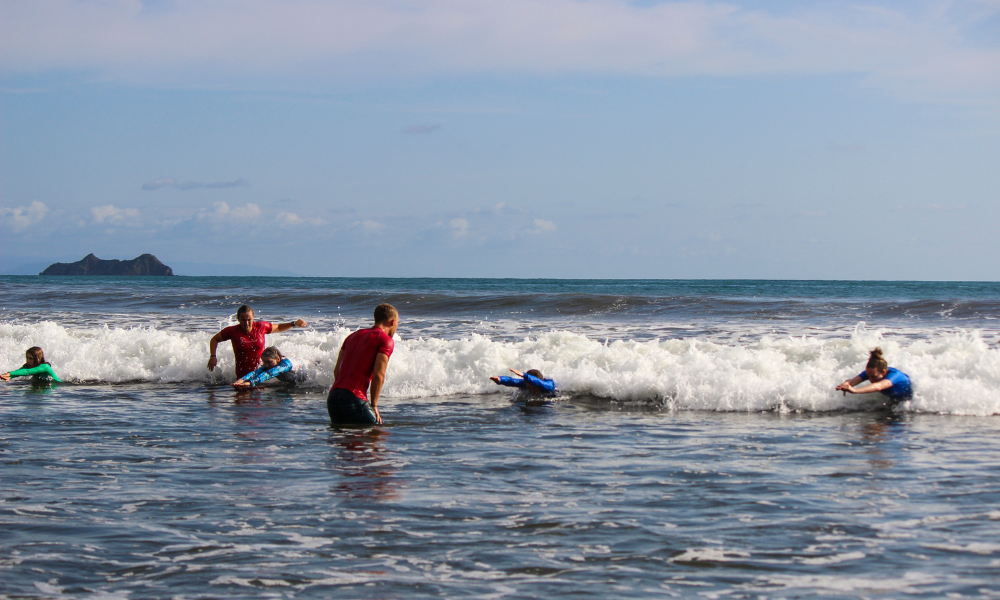This is a follow-up post to How Surf Tourism Can Inspire Environmental Stewardship.
How surf travel has contributed to the rise in overtourism
Despite the positive impact of surfing in many regards, its dominant narratives have also presented some challenges: the comparison between men and women, the objectification of the latter, and the disregard for the preservation of the natural world and the cultural differences that define it. – Lauren Hill, professional surfer and ecofeminist
Surf and travel have been inextricably linked since the release of the popular surf film The Endless Summer in 1966, which followed two California surfers as they traveled around the world searching for perfect waves to ride.
Although it is praised as one of the greatest surf films of all time, The Endless Summer made some rather unfortunate mistakes.
For one, instead of highlighting surfing as a ritualized pastime native to ancient Polynesian, Peruvian, and West African cultures, the film framed surfing as a sport belonging to the visiting Californians (both white males), thus positioning these “Western conquerors” as the dominant purveyors of the sport.
What is more, The Endless Summer glorified the concept of scouring the globe for previously unridden waves—a carbon-intensive luxury that would have negative environmental consequences for generations to come.
According to surf historian, Matt Warshaw, “After Endless Summer, anyone with a few extra minutes and an atlas could figure out that a huge majority of the world’s breaks still waited to be discovered.”
As surfing continued its post-WWII ascent into mainstream culture—and surf breaks in California, Hawaii, Australia, and Brazil became overcrowded—the concept of traveling to faraway surf-rich destinations was further normalized.
The growth in surf tourism, much like the growth in the surf industry itself, boomed into a resource-extractive process, while exotic surf trips became known as “strike missions,” with very little cultural exchange happening between tourists and locals.
In recent years, the proliferation of social media apps like Twitter, Facebook, and Instagram has added even more tourism pressure on surf destinations like Hawaii, Bali, and the Maldives—selling the idea that near-perfect waves are just a click away.
As Travis Bays—co-founder of Bodhi Surf + Yoga, a Center for Responsible Travel (CREST) Platinum Sponsor tourism business located in Costa Rica—noted in our previous blog post:
The search for novel, uncrowded surf breaks is something that is inherent in many surfers, and the drive to “discover” the best waves in the world is a natural tendency. What has happened though, is that surf media and popular culture have played a role in making this discovery much easier. Unfortunately, these newfound waves are often located in developing coastal communities that don’t have the proper infrastructure in place to accommodate the rapid influx of tourism that inevitably follows, which often leads to overcrowding and environmental degradation.
The “overcrowding and environmental degradation” of popular surf travel destinations, also known as overtourism, often results in diminished travel experience, wear and tear on built heritage, and/or negative impacts on residents.

Is surf tourism all bad?
Let’s not forget that surfing takes place in the natural world, and many surfers have played vital roles in protecting renowned surf breaks from irresponsible coastal development.
In fact, surfers have been at the forefront of the environmental movement for decades, and have created powerful environmental nonprofit organizations like Surfrider Foundation, Surfers Against Sewage, Save the Waves, and many more.
To be a surfer is to be an environmentalist—someone who respects the ocean and mitigates their impact on the planet.
And yet, to be a surfer is also to be a traveler and consumer of a multi-billion dollar mainstream industry—therein lies the rub.
Unfortunately, the continuous growth of surfing threatens the very medium in which the sport takes place, as the world’s oceans are responsible for sequestering the hundreds of thousands of tons of CO₂ that the global surf industry itself, including surf tourism, emits each year.
The good news is that there are other less-extractive models of surf tourism that exist.
It turns out that many surfers today are willing to pay more for sustainable surf tourism offerings, which “can benefit the local community and its environment in the form of promoting actions of citizen science and awareness, contributing to the public water safety and site awareness, enhancing community activities for village beautification, or organizing campaigns and community events for beach cleaning.” (Surfing the waves: Environmental and socio-economic aspects of surf tourism and recreation)
One such destination is Bodhi Surf + Yoga, a small ecotourism business located in the Southern Pacific Zone of Costa Rica, that utilizes surfing, yoga, nature immersion, and community engagement to inspire pro-environmental behavior changes among its guests.
From composting and recycling to sourcing solar energy and offsetting carbon emissions, Bodhi Surf + Yoga’s business practices revolve around the principle of minimizing its impact on the natural world.
In 2016, it became the first B Corp Certified surf and yoga camp in the world, and has earned a “Best for the World” B Corp recognition every year since. Additionally, Bodhi Surf + Yoga is a member of 1% for the Planet, voluntarily donating one percent of its gross annual sales to support environmental nonprofits.
Surf tourism, done responsibly, can also bring many socio-economic benefits to community members, such as offering new opportunities for economic growth, providing language and cultural acquisitions for residents, challenging negative gender and cultural stereotypes, and promoting personal health and well-being.
There are many ways that stakeholders in the surf tourism sector can foster the above socio-economic benefits, but one of the easiest (and most overlooked) is teaching individuals how to bodysurf.

How bodysurfing fits into a destination stewardship model
A healthy and happy community is needed to support a healthy and happy tourism industry long-term. For too long, tourism development in the name of financial benefit for a few has occurred at the expense of the people who actually spend every day in a place. Their natural and cultural assets, and even their very neighborhoods, become commodified to the point where the community itself cannot enjoy them.– Samantha Bray, former CREST Managing Director
Destination stewardship is defined by the Global Sustainable Tourism Council as “a process by which local communities, governmental agencies, NGOs, and the tourism industry take a multi-stakeholder approach to maintaining the cultural, environmental, economic, and aesthetic integrity of their country, region, or town.”
If we examine surf tourism through this lens, then it is clear that surfing beaches are natural/cultural assets that demand a more inclusive, multi-stakeholder approach.
One of the challenging aspects of fitting surf tourism into the destination stewardship model, however, is that many surfers travel to faraway places to avoid other surfers.
The surf zone should be a shared space for all to enjoy, but historically, this has not been the case, and many surf lineups today are dominated by people of privilege.
Bodysurfing, on the other hand, may be able to counteract this trend, as it is the most inclusive and accessible version of wave-riding that exists: “Surfers don’t like seeing each other, but we bodysurfers are exactly the opposite. We love seeing each other. We’re happy to share.” (The Rush of Bodysurfing in Rio)
Bodysurfing represents a relinquishing of mainstream surfing’s status quo, and a shift toward a more environmentally responsible method of riding waves. There is almost no money, and therefore no industry, in the sport of bodysurfing—a pair of decent swim fins is all one really needs to participate.
Furthermore, bodysurfers are not separate from the ocean, but part of it, which can positively influence the individual’s mindset and attitude toward the natural world.
No, I am not suggesting that surfers trade in their surfboards for swim fins to make the sport more sustainable. I am simply proposing that we consider bodysurfing as an empowering tool that can provide greater access to the ocean for a variety of stakeholders under the destination stewardship model.
Bodhi Surf + Yoga has already paved the way in this regard, having taught hundreds of students how to bodysurf since officially incorporating bodysurfing into its learn-to-surf curriculum back in 2020.
Bodysurfing should be taught not only to tourists visiting surf destinations, but also to residents who may not have the financial means to take swim lessons or learn to surf. Bodysurfing may also become an important life saving tool in communities that are traditionally afraid of the ocean, or where drownings frequently occur due to the prevalence of large waves and strong rip currents, and the lack of funding for ocean lifeguards.
Not only should it be taught more widely but also organizations like the International Surfing Association (ISA) and the Academy of Surfing Instructors ought to reevaluate their coaching programs to include bodysurfing lessons. That way, surf schools and lodges would have the knowledge and capacity to offer bodysurfing lessons to residents and visitors alike.
When all is said and done, surfers will play an important role in the global pro-environmental movement, and mitigating the negative impacts of surf travel is an obvious place to start. One surefire way to promote this shift in mindset is by disseminating the skill of bodysurfing to the masses, allowing for a simpler, more accessible wave-riding experience for all.

Spencer Dunlap
After graduating from the University of San Diego with a Bachelor’s degree in environmental studies, Spencer moved to Costa Rica where he has worked as an ISA certified surf coach, environmental consultant, and blog writer for Bodhi Surf + Yoga since 2019.
Spencer helped Bodhi Surf + Yoga become the first surf and yoga camp in the world to achieve carbon neutrality in 2019. The following season, he helped create Bodhi Awaken, a two-week ocean awareness retreat that features both bodysurfing and board-surfing. Spencer has written over 50 articles about surfing, bodysurfing, nature, and environmentalism, published in various media outlets such as The Inertia, Elephant Journal, CREST, and Medium.

